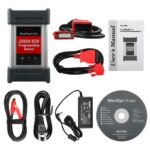Adaptation with VCDS allows you to modify specific values and settings within your car’s control modules. This powerful functionality enables customization and troubleshooting but requires careful understanding and execution. This guide provides a detailed overview of the adaptation process using VCDS.
Understanding VCDS Adaptation Channels
VCDS allows access to adaptation channels using function 10 (corresponding to VAG 1551/1552). You can navigate through these channels using the [Up] and [Dn] buttons or manually enter the channel number. Each channel corresponds to a specific setting or value. VCDS displays the “Stored Value” for each existing channel, indicating the current setting. Non-existent channels will display “N/A.”
Testing and Saving New Values
Once you’ve selected a channel, you can adjust the “New Value” using the [Up] and [Dn] buttons for incremental changes or directly input a value. Crucially, before permanently changing any settings, you should use the [Test] function. This allows the controller to temporarily use the new value, enabling you to assess its effects on the vehicle’s behavior. Only after thorough testing should you click [Save] to permanently store the new value in the controller.
Adaptation Label Files and Drop-Down Menus
VCDS label files provide valuable context for adaptation channels, often including descriptions and acceptable value ranges. For modules with supporting label files, a drop-down menu may be available, presenting a list of functions corresponding to the channels. This menu simplifies navigation and understanding of the available adjustments.
UDS Protocol and Adaptation
Controllers using the UDS/ODX/ASAM protocol require using the drop-down menu for adaptation. Traditional adaptation channels do not apply to these controllers. Channel names often align with factory identifiers (e.g., IDEnnnnn). A search function within the drop-down menu allows for efficient filtering of available channels. VCDS supports Adaptation for all control modules in the VW Crafter / LT3. For UDS controllers, you may need to enter Workshop Code (WSC), Importer, and Equipment numbers.
Soft Reset and Long Adaptation
The “Soft Reset” option prompts the control module to reboot after changes are made. This is sometimes necessary for changes to take effect in certain UDS modules. “Long Adaptation,” a specific type of adaptation, is used for tasks like balancing fuel injectors in Common-Rail TDI engines.
Handling Uninitialized Control Module Warnings
An uninitialized control module warning indicates that the WorkShop Code, Importer, or Equipment numbers are set to zero. Some modules require non-zero values in these fields to save adaptation changes. VCDS offers options to automatically fill these fields with default values (12345/123/12345), use existing values, or manually enter them.
Conclusion: Utilizing VCDS Adaptation Effectively
Adaptation with VCDS offers extensive control over vehicle settings. However, it’s crucial to proceed cautiously, thoroughly testing changes before saving them permanently. Utilizing label files, understanding UDS protocol specifics, and correctly handling uninitialized module warnings are essential for successful adaptation. Remember to use the [Add to Log] function to document changes and always consult reliable resources for guidance on specific adaptation procedures.

